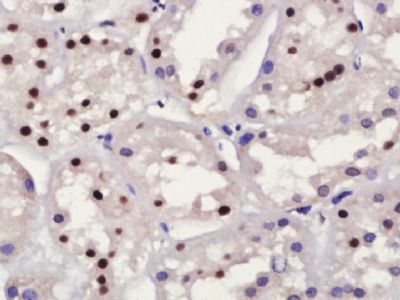CBLB (Cas Br M (murine) ecotropic retroviral transforming sequence b) has high homology to CBL, the proto-oncogene that induces pre-B cell lymphomas and myeloid leukemias in mice. Like CBL, CBLB contains putative nuclear localization signal, zinc finger, leucine zipper, and proline-rich domains. CBLB associates with FYN, FGR, and PLCG1. Acts an E3 ubiquitin-protein ligase which accepts ubiquitin from specific E2 ubiquitin-conjugating enzymes, and transfers it to substrates, generally promoting their degradation by the proteasome. Negatively regulates TCR (T-cell receptor), BCR (B-cell receptor) and FCER1 (high affinity immunoglobulin epsilon receptor) signal transduction pathways. In naive T-cells, inhibits VAV1 activation upon TCR engagement and imposes a requirement for CD28 costimulation for proliferation and IL-2 production. Also acts by promoting PIK3R1/p85 ubiquitination, which impairs its recruitment to the TCR and subsequent activation. In activated T-cells, inhibits PLCG1 activation and calcium mobilization upon restimulation and promotes anergy. In B-cells, acts by ubiquitinating SYK and promoting its proteasomal degradation. May also be involved in EGFR ubiquitination and internalization. In addition to its role in the prevention of chronic inflammation and autoimmunity, CBLB also has a function in acute lung inflammation. There are 4 isoforms produced by alternative splicing.
Function:
E3 ubiquitin-protein ligase which accepts ubiquitin from specific E2 ubiquitin-conjugating enzymes, and transfers it to substrates, generally promoting their degradation by the proteasome. Negatively regulates TCR (T-cell receptor), BCR (B-cell receptor) and FCER1 (high affinity immunoglobulin epsilon receptor) signal transduction pathways. In naive T-cells, inhibits VAV1 activation upon TCR engagement and imposes a requirement for CD28 costimulation for proliferation and IL-2 production. Also acts by promoting PIK3R1/p85 ubiquitination, which impairs its recruitment to the TCR and subsequent activation. In activated T-cells, inhibits PLCG1 activation and calcium mobilization upon restimulation and promotes anergy. In B-cells, acts by ubiquitinating SYK and promoting its proteasomal degradation. May also be involved in EGFR ubiquitination and internalization. [PATHWAY] Protein modification; protein ubiquitination.
Subunit:
Interacts with SH3 domain-containing proteins LCK, CRK and SORBS1. Interacts with LCP2 and ZAP70. May interact with CBL. Interacts with SH3 domain-containing proteins VAV1, FYN, FGR, PLCG1, GRB2, CRKL, PIK3R1 and SH3KBP1/CIN85. Identified in heterotrimeric complexes with SH3KBP1/CIN85, CD2AP and ARHGEF7, where one CBLB peptide binds two copies of the other protein. Interacts with poly-ubiquitinated proteins. Dimerization is required for the binding of poly-ubiquitin, but not for the binding of mono-ubiquitin.
Subcellular Location:
Cytoplasmic and Nuclear
Tissue Specificity:
Expressed in placenta, heart, lung, kidney, spleen, ovary and testis, as well as fetal brain and liver and hematopoietic cell lines, but not in adult brain, liver, pancreas, salivary gland, or skeletal muscle. Present in lymphocytes (at protein level).
Post-translational modifications:
Phosphorylated on tyrosine and serine residues upon TCR or BCR activation, and upon various types of cell stimulation.
Auto-ubiquitinated upon EGF-mediated cell activation or upon T-cell costimulation by CD28; which promotes proteasomal degradation.
Similarity:
Contains 1 Cbl-PTB (Cbl-type phosphotyrosine-binding) domain.
Contains 1 RING-type zinc finger.
Contains 1 UBA domain.
SWISS:
Q13191
Gene ID:
868
Database links:
Entrez Gene: 868 Human
Entrez Gene: 208650 Mouse
Entrez Gene: 171136 Rat
Omim: 604491 Human
SwissProt: Q13191 Human
SwissProt: Q3TTA7 Mouse
SwissProt: Q8K4S7 Rat
Unigene: 430589 Human
Unigene: 328206 Mouse
Unigene: 21799 Rat
| Picture |
Paraformaldehyde-fixed, paraffin embedded (Human kidney); Antigen retrieval by boiling in sodium citrate buffer (pH6.0) for 15min; Block endogenous peroxidase by 3% hydrogen peroxide for 20 minutes; Blocking buffer (normal goat serum) at 37°C for 30min; Antibody incubation with (RNF56) Polyclonal Antibody, Unconjugated (SL5949R) at 1:400 overnight at 4°C, followed by operating according to SP Kit(Rabbit) (sp-0023) instructionsand DAB staining.
|
|
|
